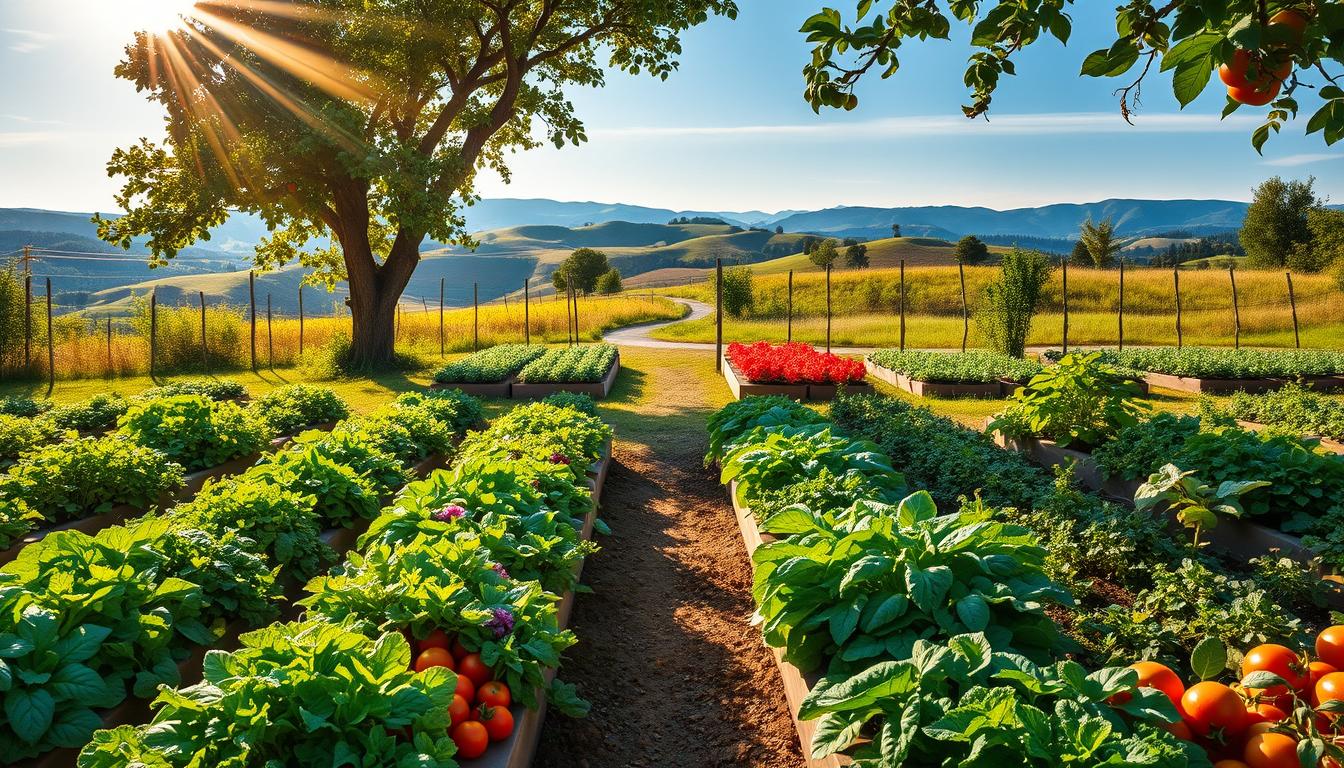Planning your garden layout can make a big difference in how well your plants grow. A well-thought-out design helps you use space efficiently, control pests, and extend your harvest. Whether you have a small yard or prefer raised beds, there’s a solution for every gardener.
Strategies like vertical gardening and companion planting can maximize your yield. For example, pairing tomatoes with basil not only saves space but also enhances flavor. Steven Biggs’ front-yard conversion project shows how creative planning can turn any area into a thriving garden.
Seasonal considerations are also key. Succession crops ensure you have fresh produce year-round. Studies show that proper layouts can increase yields by over 20%. Balancing functionality with visual appeal creates a garden that’s both productive and beautiful.
Key Takeaways
- Optimize space with vertical gardening and raised beds.
- Use companion planting to improve plant health and flavor.
- Plan for seasonal crops to extend your harvest.
- Adapt designs to fit small yards or containers.
- Balance functionality with aesthetics for a visually appealing garden.
Introduction to Vegetable Garden Layouts
Understanding the basics of garden designs can transform how you grow your plants. Over time, methods have shifted from traditional farm rows to modern, space-efficient techniques. This evolution allows gardeners to maximize yields while maintaining a visually appealing setup.
One key difference between ornamental and edible gardens is the focus on functionality. While ornamental gardens prioritize aesthetics, edible gardens emphasize productivity. Steven Biggs’ “growing in blocks” method is a prime example of this shift. By grouping plants in blocks rather than rows, he achieved higher efficiency and healthier crops.
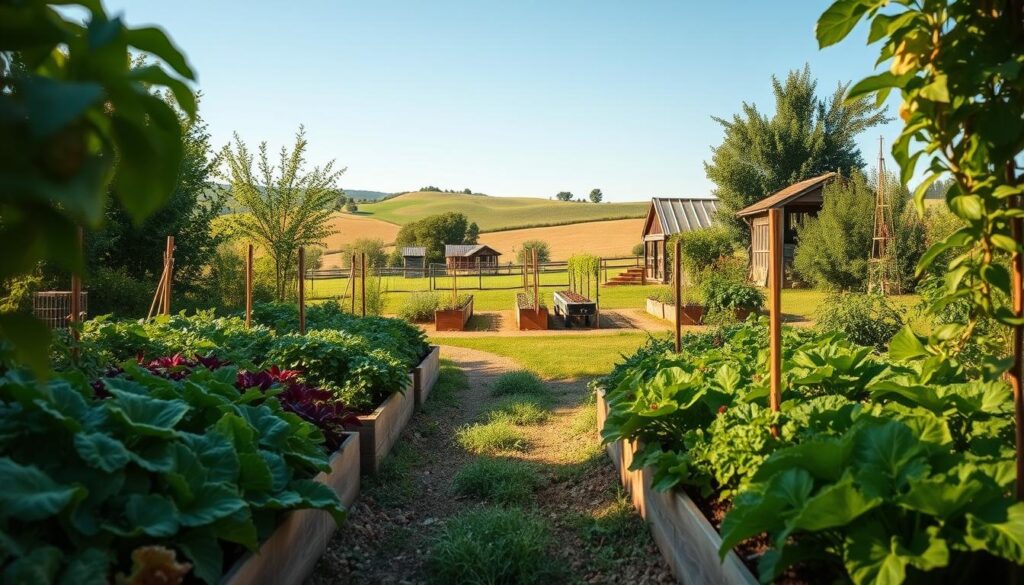
Assessing your microclimate is another crucial step. Factors like sun exposure, wind, and soil type play a significant role in plant selection. For instance, shade-tolerant greens can thrive under A-frame cucumber trellises, making vertical gardening a smart choice for small spaces.
Container gardening is another innovative approach. Projects like driveway tomato setups demonstrate how even limited areas can yield impressive results. Companion planting, supported by research from Plant Partners, further enhances plant health and productivity.
Budget considerations also matter. Whether you choose raised beds or in-ground planting, each option has its advantages. Raised beds offer better soil control, while in-ground planting is often more cost-effective. By balancing these factors, you can create a garden that’s both productive and sustainable.
For beginners, starting small is key. Learn more about gardening basics to build a strong foundation. With careful planning and the right techniques, your garden can flourish year-round.
Assessing Your Garden Space
Evaluating your garden space is the first step to a thriving setup. Understanding the unique conditions of your area helps you choose the right plants and techniques. Whether you have a sunny backyard or a shaded corner, proper assessment ensures healthier growth and higher yields.
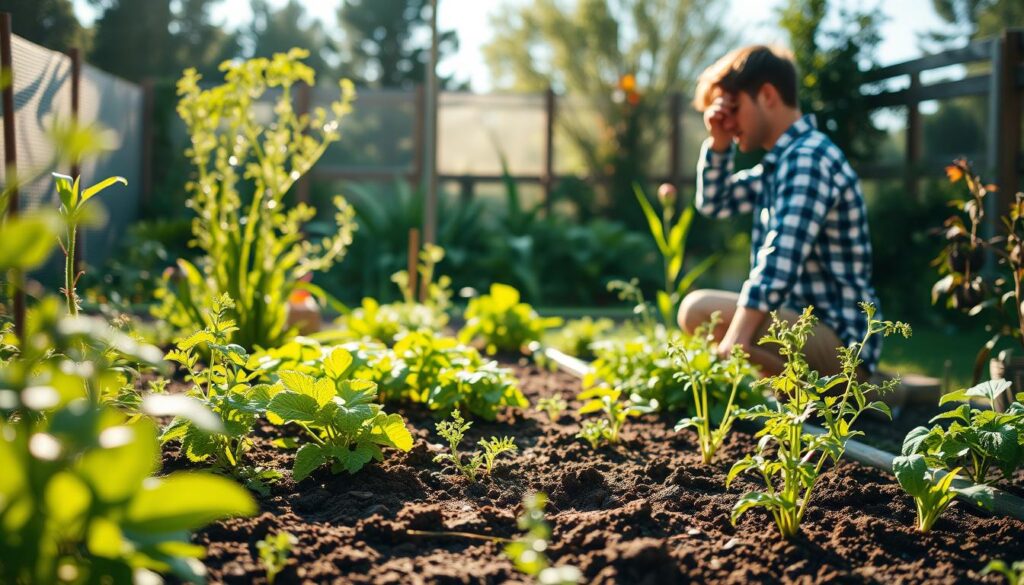
Sunlight Requirements
Most vegetables need 6-8 hours of direct sunlight daily. Use smartphone apps to map the sun’s path in your garden. This helps identify the sunniest spots and areas with partial shade.
For shaded areas, consider leafy greens like spinach or root vegetables such as carrots. These plants thrive with less sunlight. Avoid planting near walnut trees, as their roots release toxins harmful to many plants.
Water Access and Soil Conditions
Plan your water access early. Drip irrigation systems are efficient and conserve water. Assess your soil type—sandy, clay, or loamy—to determine its drainage and nutrient retention.
If your garden has slopes, ensure proper drainage to prevent waterlogging. Reflective surfaces like white stones can create microclimates, enhancing sunlight exposure for certain plants.
Existing Vegetation and Noise Buffers
Manage existing vegetation carefully. Use root barriers to prevent invasive tree roots from affecting your garden. Tall crops like corn can act as noise buffers, reducing external disturbances.
Consider your USDA hardiness zone when selecting plants. This ensures they can thrive in your local climate. Keyhole garden designs are efficient, offering easy access to plants while maximizing space.
| Plant Type | Sunlight Requirement | Notes |
|---|---|---|
| Tomatoes | 6-8 hours | Full sun, avoid shade |
| Spinach | 3-4 hours | Partial shade, cool season |
| Carrots | 4-6 hours | Partial shade, well-drained soil |
| Peppers | 6-8 hours | Full sun, warm season |
By assessing your garden space thoroughly, you can create an environment where plants thrive. From sunlight to soil, every detail matters in building a productive and sustainable garden.
Choosing the Right Vegetables for Your Garden
Selecting the right plants for your space ensures a bountiful harvest. A thoughtful approach to crop selection can maximize productivity and make gardening more enjoyable. Whether you’re growing in raised beds, containers, or traditional rows, the key is to match your choices to your available space and personal preferences.

Crop Selection Strategies
Steven Biggs’ principle of “avoid space hogs” is a great starting point. Focus on plants that yield high returns without taking up too much room. For example, pole beans and Malabar spinach are excellent vertical candidates, while patio tomatoes and dwarf citrus thrive in containers.
Balancing high-yield crops with novelty varieties adds diversity to your garden. Consider integrating perennials like asparagus beds or berry canes for long-term benefits. Crop rotation is also essential to prevent diseases and maintain soil health.
Miracle-Gro® soil recommendations can help you create the ideal growing environment. For instance, edamame and bush beans have different yield potentials, so choose based on your needs. Succession planting ensures a continuous harvest throughout the season.
| Plant | Space Requirement | Notes |
|---|---|---|
| Tomatoes | Medium | Requires staking or cages |
| Pole Beans | Vertical | Ideal for trellises |
| Spinach | Compact | Cool-season crop |
| Dwarf Citrus | Container | Perfect for patios |
Personalize your selection based on what you love to eat. Seed catalogs offer a wealth of heirloom varieties to explore. By combining these strategies, you can create a garden that’s both productive and tailored to your tastes.
Planning Your Garden Layout on Paper
Mapping out your garden on paper is a game-changer for productivity and organization. It helps you visualize your space, avoid overcrowding, and ensure every plant gets the care it needs. Whether you’re a beginner or a seasoned gardener, a well-thought-out plan can save time and effort.
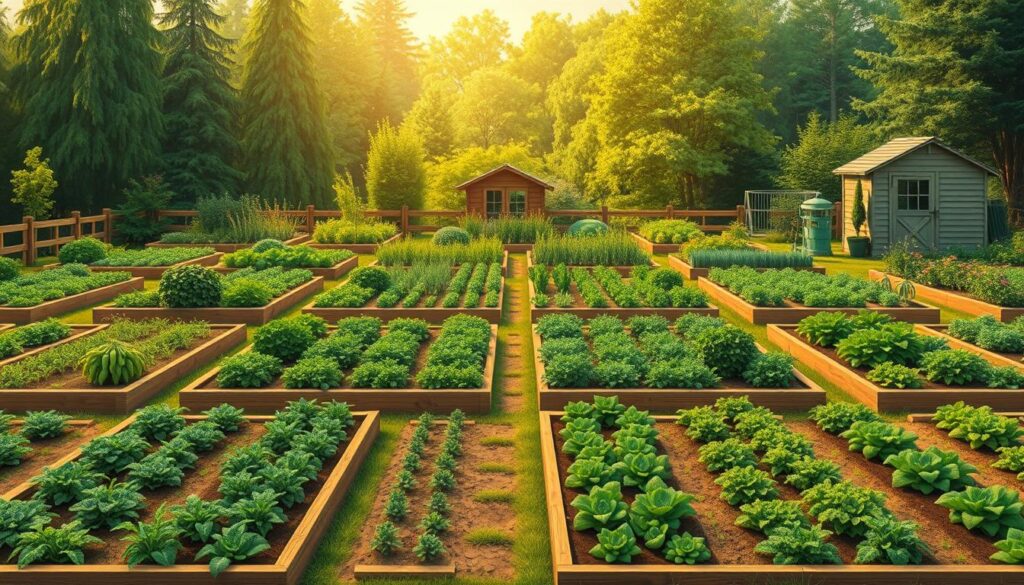
Start by using 1:1 scale graph paper or digital tools like the Almanac Garden Planner. These methods allow you to create accurate representations of your space. A 3-4ft bed width is ideal for accessibility, ensuring you can reach all plants without stepping on the soil.
Scale Drawing Techniques
Hand-drawn plans are great for those who enjoy a tactile approach. Use graph paper to sketch beds, pathways, and plant placements. For a more advanced option, digital tools offer templates and features like sun tracking overlays. These can help you position tall crops where they won’t shade smaller plants.
Succession planting can be visually mapped to ensure continuous harvests. Mark soil amendment zones and companion planting clusters to optimize plant health. Crop rotation templates are also useful for planning multi-year layouts.
“A good plan is like a roadmap—it guides you to your destination without unnecessary detours.”
Pathway optimization is another key factor. Keyhole designs maximize space while providing easy access to plants. Plan harvest routes to minimize damage to crops. By combining these techniques, you’ll create a garden that’s both functional and efficient.
Maximizing Space with Raised Beds
Raised beds offer a versatile solution for optimizing your gardening space. They provide better soil control, improved drainage, and easier access to plants. Whether you’re growing tomatoes, beans, or root vegetables, raised beds can enhance productivity and simplify maintenance.
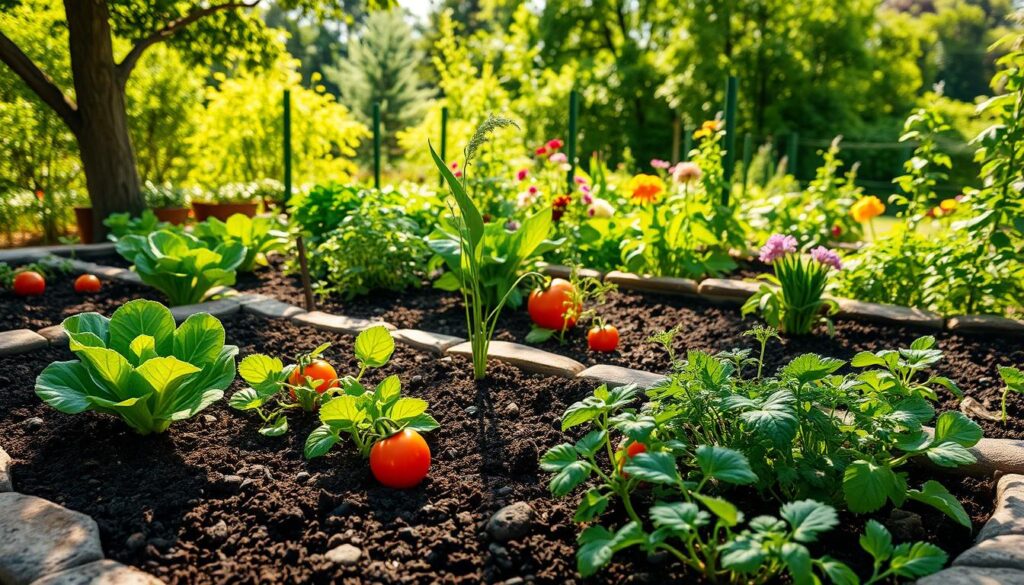
One of the key advantages of raised beds is their adaptability. They can be built to fit any area, from small patios to expansive yards. Steven Biggs’ elevated pepper container solution is a great example of how raised beds can be tailored to specific needs.
Construction Best Practices
When building raised beds, material choice is crucial. Cedar and composite lumber are popular options due to their durability and resistance to rot. Cedar is naturally pest-resistant, while composite materials offer a longer lifespan.
Depth is another important factor. Root vegetables like carrots require deeper beds, typically 12-18 inches. For wheelchair accessibility, aim for a height of 24-30 inches. This ensures comfort and ease of use for all gardeners.
Thermal mass benefits make raised beds ideal for early planting. Materials like stone or concrete retain heat, extending the growing season. Adding a pest-proof lining can protect your plants from burrowing animals.
Self-watering reservoir systems are a smart addition. They reduce water waste and ensure consistent moisture levels. Cold frame integration can further extend the growing season, allowing you to harvest fresh produce even in cooler months.
Succession planting in layered soil maximizes yield. By rotating crops and replenishing nutrients, you can maintain soil health and productivity. These techniques make raised beds a practical and efficient choice for any garden.
Incorporating Vertical Gardening Techniques
Vertical gardening is a smart way to grow more in less space. By using structures like trellises, walls, and hanging baskets, you can maximize your planting area. This method is especially useful for small yards or urban settings where horizontal space is limited.
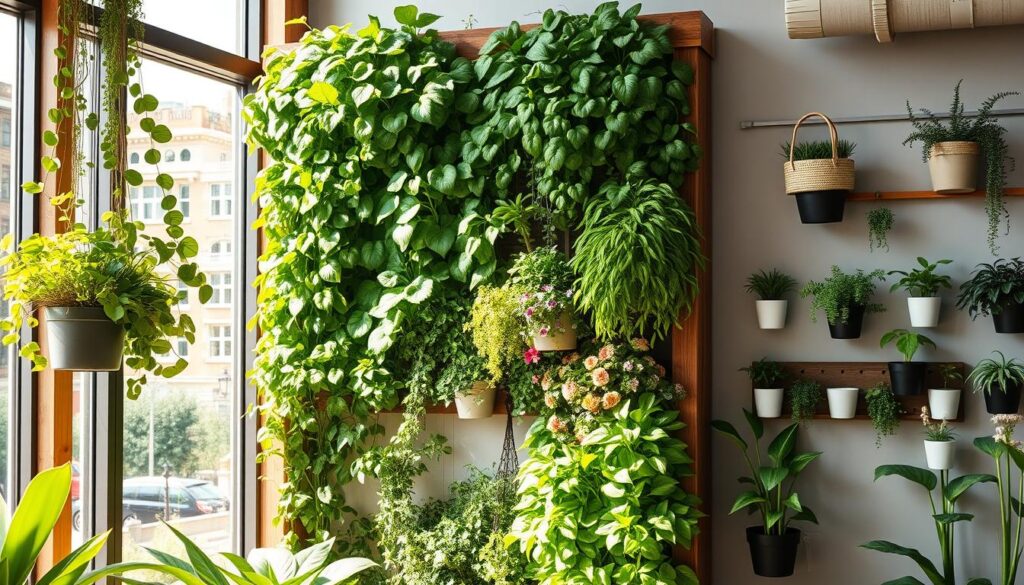
One popular technique is the A-frame cucumber and lettuce combo. This setup allows you to grow two crops in the same vertical space. Bolivian cucumbers, known for their high yield, thrive in such systems. Hanging baskets are another great option for herbs like basil and thyme.
Choosing the Right Trellis System
Trellises are essential for supporting climbing plants like tomatoes and beans. They come in various materials, including wood, metal, and bamboo. When selecting a trellis, consider the weight of the plants. Squash, for example, requires a sturdy structure to bear its weight.
Living walls and espaliered fruit trees are other creative options. Living walls use irrigation systems to keep plants hydrated, while espaliered trees are trained to grow flat against a surface. Both methods save space and add visual interest to your garden.
| Method | Best For | Benefits |
|---|---|---|
| A-Frame Trellis | Cucumbers, Lettuce | Dual-crop efficiency |
| Living Wall | Herbs, Small Plants | Space-saving, aesthetic |
| Espaliered Trees | Fruit Trees | Compact growth, decorative |
Wind exposure is another factor to consider. Tall structures can act as windbreaks, protecting delicate plants. Harvesting ergonomics are also important. Ensure that your vertical setup allows easy access to all plants for maintenance and picking.
Vertical gardening can even create shade for heat-sensitive crops like spinach. By positioning taller plants strategically, you can shield smaller ones from intense sun. This technique ensures that every plant gets the conditions it needs to thrive.
Companion Planting for a Healthier Garden
Companion planting is a natural way to boost your garden’s health and productivity. By pairing specific plants together, you can create a thriving ecosystem that supports growth, deters pests, and improves soil quality. This method has been used for centuries and is backed by modern research.
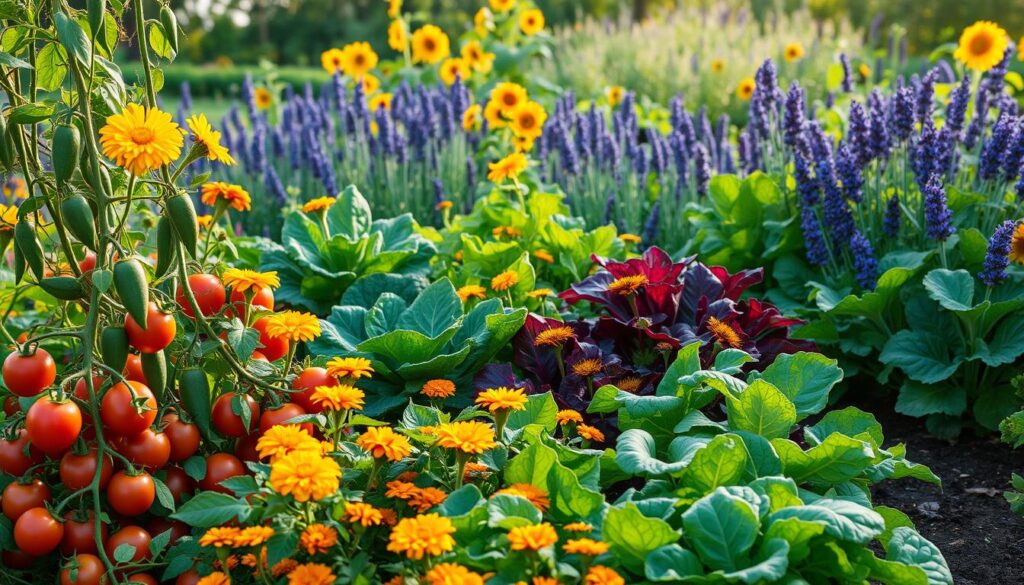
One example is radish and carrot interplanting. Studies show that radishes grow quickly, loosening the soil for carrots, which take longer to mature. This combination maximizes space and improves yield. Similarly, marigolds are known to suppress nematodes, protecting nearby crops like tomatoes and beans.
Science-Based Pairings
Research from the University of Minnesota highlights the benefits of nitrogen-fixing plants like beans. When paired with heavy feeders like corn, beans enrich the soil, reducing the need for fertilizers. Another effective strategy is pest-confusing fragrance pairings. For instance, planting basil near tomatoes can repel aphids and enhance flavor.
Trap cropping is another innovative approach. By planting sacrificial crops like nasturtiums, you can lure pests away from your main vegetables. Pollinator-attracting flower strips, such as those with lavender or sunflowers, also play a vital role in supporting beneficial insects.
“Companion planting is not just about growing plants together—it’s about creating a balanced ecosystem.”
However, be cautious with allelopathic plants like black walnut, which release chemicals that inhibit the growth of nearby crops. Adapting traditional methods like the Three Sisters garden—corn, beans, and squash—can also yield impressive results. These plants support each other’s growth, creating a sustainable and productive system.
Succession companion strategies ensure continuous harvests. For example, planting spinach after harvesting early-season crops like peas keeps the soil productive. While container gardening has limitations, pairing herbs like thyme with compact vegetables like peppers can still yield great results.
By understanding these science-based pairings, you can create a healthier, more productive garden. Companion planting is a simple yet powerful way to enhance your gardening experience.
Succession Planting for Continuous Harvest
Keeping your garden productive year-round requires smart planning and timing. Succession planting ensures you always have fresh produce, even as seasons change. By rotating crops strategically, you can maximize your harvest and make the most of your space.
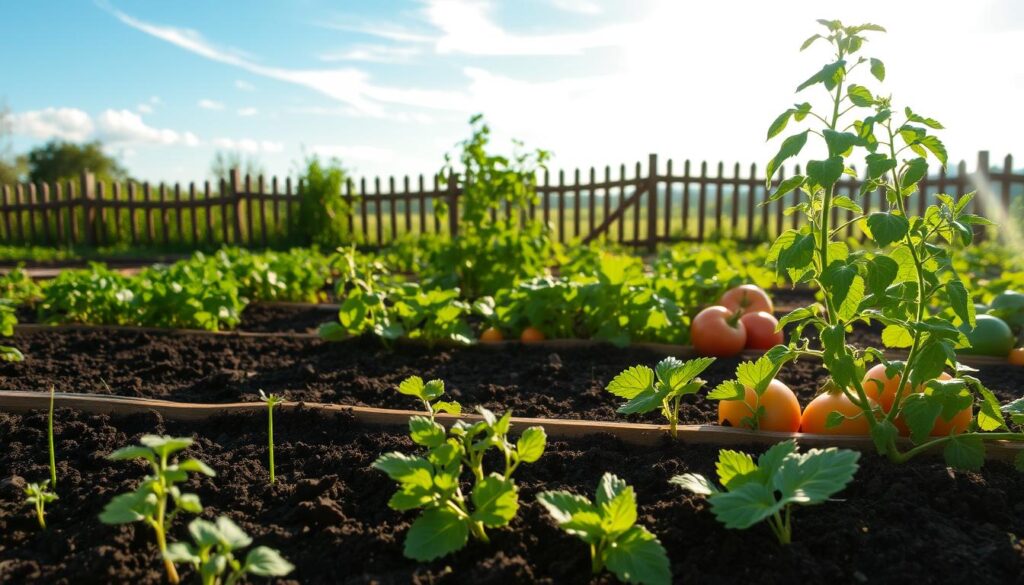
Steven Biggs’ rapini and garlic rotation is a great example. After harvesting rapini in early summer, he plants garlic for a fall harvest. This method keeps the soil active and prevents nutrient depletion. Similarly, a 150-day growing season strategy allows you to plant multiple crops in the same space.
Seasonal Transitions
Timing is everything in succession planting. Start by selecting heat-tolerant varieties for summer and cool-season crops for fall. Overwintering crops like kale and spinach can extend your harvest into winter. Use seed starting timelines to ensure your plants are ready for each season.
Fall garden preparation is key. Clear out spent summer crops and amend the soil for cool-season plants. Transplanting seedlings can save time compared to direct seeding. Track crop maturity dates to plan your next planting cycle effectively.
| Season | Crop Type | Notes |
|---|---|---|
| Spring | Lettuce, Peas | Cool-season, fast-growing |
| Summer | Tomatoes, Beans | Heat-tolerant, full sun |
| Fall | Garlic, Spinach | Cool-season, overwintering |
Square-foot garden replanting schedules can help you stay organized. For example, after harvesting beans, plant radishes or carrots in the same space. This ensures continuous use of your garden beds and maximizes yield.
Storage crop timing is another consideration. Plant root vegetables like carrots and beets in late summer for winter storage. By combining these techniques, you can create a garden that thrives across all seasons.
Efficient Watering and Irrigation Systems
Proper irrigation is key to maintaining healthy plants and soil. With the right systems, you can conserve water, save time, and ensure your garden thrives. Whether you’re using raised beds, containers, or traditional plots, efficient watering makes a big difference.
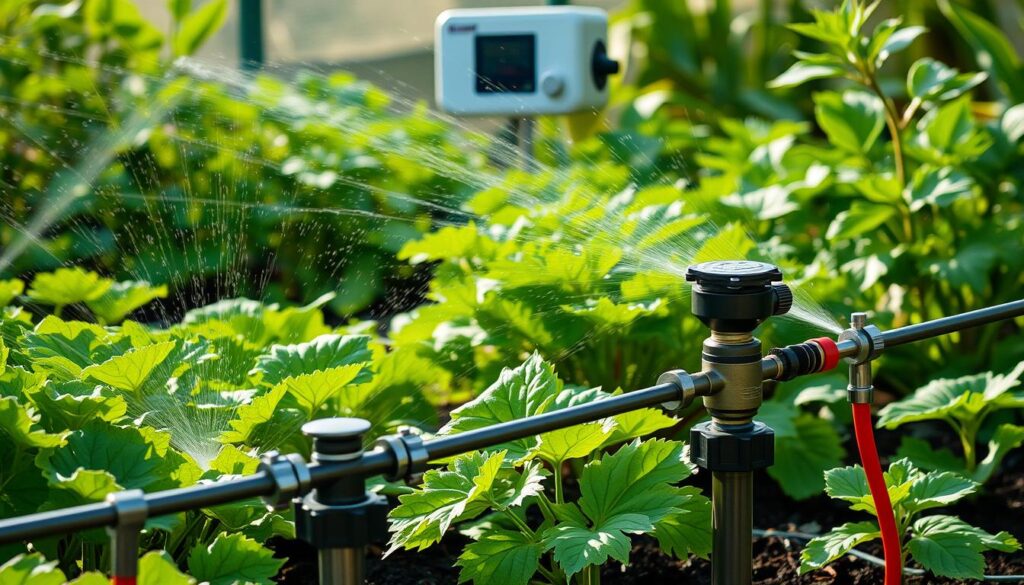
Drip irrigation is one of the most effective methods. It delivers water directly to the roots, reducing evaporation and saving up to 50% more water than traditional sprinklers. Straw mulch is another great way to conserve moisture. It keeps the soil cool and reduces evaporation, especially during hot, sunny days.
Water Conservation Methods
Self-watering containers are perfect for small spaces or busy gardeners. These designs use reservoirs to provide consistent moisture, reducing the need for frequent watering. Zoned irrigation controllers allow you to customize watering schedules for different areas of your garden, ensuring each plant gets the right amount of water.
Rainwater harvesting is another eco-friendly option. By collecting and storing rainwater, you can reduce your reliance on municipal water supplies. Soil moisture sensors take the guesswork out of watering. They measure the moisture level in the soil and alert you when it’s time to water.
- Olla pots, an ancient irrigation method, slowly release water to plant roots.
- Drought-tolerant crops like succulents and herbs require less water.
- Slope-based water channeling directs runoff to where it’s needed most.
- Frost protection watering can shield plants during cold snaps.
- Aquatic edible plants like watercress thrive in wet conditions.
“Efficient watering isn’t just about saving water—it’s about creating a sustainable garden that thrives year-round.”
By integrating these methods, you can create a garden that’s both productive and water-efficient. From drip systems to rainwater harvesting, every step counts toward a healthier, more sustainable space.
Managing Soil Health and Fertility
Healthy soil is the foundation of a thriving garden. It provides essential nutrients, supports root growth, and helps plants resist pests and diseases. By focusing on soil health, you can create a sustainable environment for your crops to flourish.
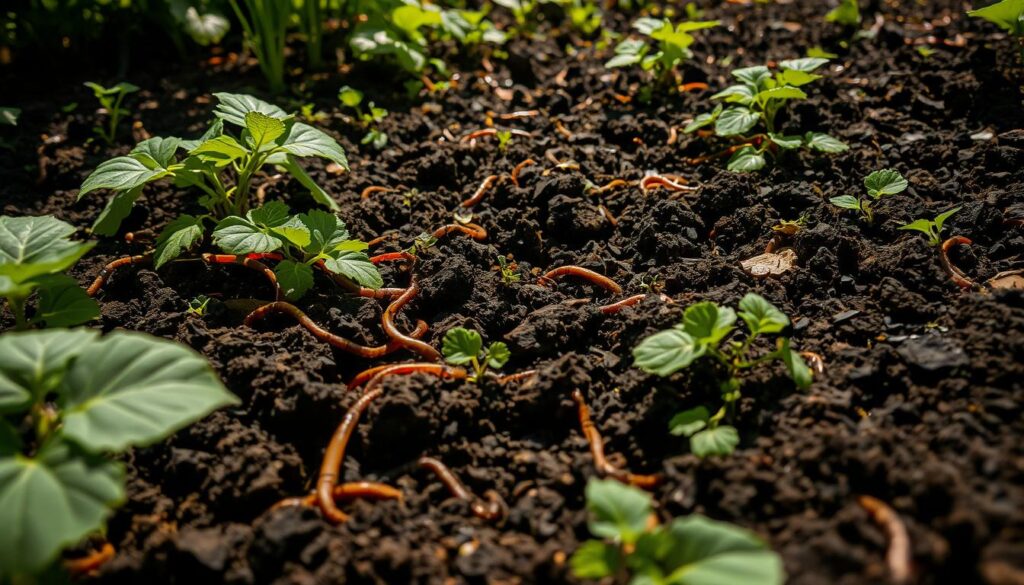
One effective way to improve soil quality is through amendment strategies. Adding organic matter like compost or biochar can enhance soil structure and fertility. Regular soil testing helps you understand nutrient levels and pH, guiding your amendment choices.
Amendment Strategies
A 3-year compost rotation cycle is a proven method to enrich soil. This involves adding compost annually to different sections of your garden, ensuring consistent nutrient replenishment. Biochar, known for its carbon sequestration rates, also improves water retention and microbial activity.
Mycorrhizal inoculation is another powerful tool. These beneficial fungi form symbiotic relationships with plant roots, enhancing nutrient uptake and overall plant health. Research shows that mycorrhizal fungi can increase crop yields by up to 30%.
- Use soil test interpretation guides to identify nutrient deficiencies.
- Select green manure crops like clover or alfalfa to fix nitrogen in the soil.
- Adjust pH levels based on crop-specific needs for optimal growth.
- Construct worm towers to boost soil aeration and nutrient cycling.
- Apply mulch to a depth of 2-3 inches to retain moisture and suppress weeds.
“Healthy soil isn’t just dirt—it’s a living ecosystem that supports your garden’s success.”
| Amendment | Benefits | Application |
|---|---|---|
| Compost | Improves soil structure, adds nutrients | Spread 1-2 inches annually |
| Biochar | Enhances water retention, sequesters carbon | Mix 5-10% into soil |
| Mycorrhizal Fungi | Boosts nutrient uptake, increases yields | Apply during planting |
By implementing these strategies, you can maintain soil health and fertility season after season. Whether you’re working with raised beds, containers, or traditional plots, healthy soil is the key to a productive garden.
Dealing with Common Garden Pests and Diseases
Protecting your plants from pests and diseases ensures a thriving garden. These challenges can damage your crops and reduce yields, but with the right strategies, you can keep your garden healthy and productive. Organic prevention tactics are a safe and effective way to manage these issues without relying on harmful chemicals.
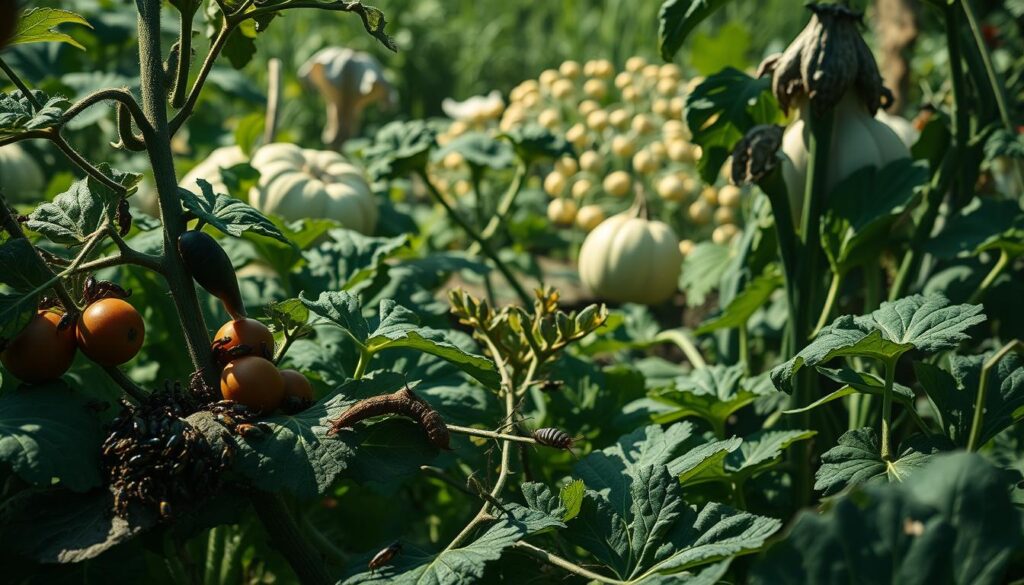
Companion planting is one of the most effective methods. Studies show that pairing certain plants can reduce pest populations by up to 60%. For example, planting marigolds near tomatoes deters nematodes, while basil can repel aphids and enhance flavor. Row covers are another great tool. They create a physical barrier that protects plants from insects while allowing sunlight and water to pass through.
Organic Prevention Tactics
Neem oil is a natural solution for controlling pests and diseases. It disrupts the life cycle of insects and prevents fungal growth. Apply it in the evening to avoid harming beneficial insects like bees. Beneficial insect hotels are another innovative approach. These structures attract pollinators and predators that naturally control pest populations.
- Integrated Pest Management (IPM) workflows combine multiple strategies for long-term control.
- Choose disease-resistant varieties of plants like tomatoes and beans to minimize risks.
- Rotate crops each season to prevent soil-borne diseases and break pest cycles.
- Maintain sanitation protocols by removing diseased plants and debris promptly.
- Use trap monitoring systems to identify and address pest issues early.
- Introduce biological controls like ladybugs to target specific pests.
- Apply weather-based risk modeling to predict and prevent disease outbreaks.
“A healthy garden starts with prevention. By using organic methods, you can protect your plants and the environment.”
These tactics not only safeguard your garden but also promote a balanced ecosystem. Whether you’re growing vegetables, fruit, or herbs, these strategies will help you maintain a thriving garden throughout the season.
Conclusion: Creating Your Best Vegetable Garden Layout
Building a thriving garden takes time, but with the right strategies, you can enjoy fresh produce year after year. Steven Biggs’ 25 years of experience highlight the importance of adaptability and continuous learning. Tools like the Almanac Planner can help you track progress and refine your approach.
Consider incorporating technology, such as smart sensors, to monitor soil and water levels. Community collaborations and educational programs for children can also enrich your gardening journey. Adaptive techniques ensure that everyone, regardless of ability, can participate.
Focus on long-term planning. Track yields, save seeds, and experiment with new methods. Whether you use raised beds or containers, the key is to stay curious and committed. With patience and effort, your garden will flourish season after season.

